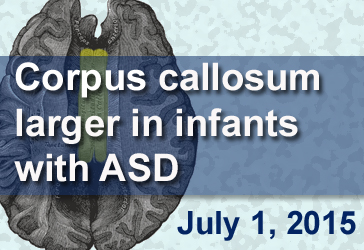Check out other stories from the Latest News
Size of Brain Area May Predict ASD in Infants
By Chelsea E. Toledo, M.A. on July 1, 2015

Background: “White matter” refers to the parts of the brain that transmit signals between brain regions. The brain’s largest white matter connection, the corpus callosum, is a thick bundle of fibers connecting the brain’s hemispheres and facilitating communication between them. Numerous studies have shown that the corpus callosum is smaller in adults and children with autism spectrum disorder (ASD) than in their typically developing counterparts.
What’s New: On May 3, 2015, the journal Brain published the first study focusing on the corpus callosum in infants at risk of developing ASD. The researchers scanned the brains of 378 children—270 with older siblings diagnosed with ASD—at 6, 12, and then 24 months of age. Fifty-seven of those children fit the ASD profile at 24 months of age. In those children, the corpus callosum was much thicker—especially at the 6- and 12-month time points, with differences diminishing as children approached 2 years of age. The finding held even when the researchers controlled for brain size, which studies have shown is larger in infants with ASD.
Why it’s important: This is the first study to examine how the size of the corpus callosum during infancy relates to ASD diagnosis. Future research could examine the biological mechanisms that lead to changes in relative corpus callosum size from infancy to child- and adulthood in those with autism. Several lines of evidence point to abnormalities in the way neuron growth and insulation is managed in the brain.
Help me understand :
| Source(s) : |
| Tweet |

